So you want to be an alpinist
![Ptarmigan Ridge]() An alpinist
An alpinistThis article is intended as an outline for an alpinist's education. It is not intended as a replacement for qualified instruction. Persons interested in learning any skill mentioned in this article are urged to seek out an AMGA or IFMGA certified mountain guide or other qualified instructor. This was written for a broad geographical audience, hence the terms 'home range' and 'home crag'. The occasional provincial references are intended for illustrative purposes only.
The history of alpinism is really the history of climbing in the European Alps. This is a fascinating subject, but lies beyond the scope of this article. An excellent article on the
history of alpinism is available on Summit Post. I introduce the subject of history as a way of defining what alpinism is. As climbing became more sophisticated, the climber of the European Alps learned how to rock climb, to aid climb, to navigate glaciers, to ski on glaciers, and to ice climb in the pursuit of new, more difficult summits and new routes.
![NW Ice Couloir - Eldorado Peak]() An alpinist
An alpinistThe skills, gear, and tactics employed to climb the steep, icy north faces, narrow runnels, sweeping rock buttresses, and jagged Aiguilles of the Alps informs the modern Alpinist, whether she plies her trade in Europe, North America, South America or Asia. Along with technical skills and tactics, the Alps inspired an ethos dubbed 'Westalpinsthil' or alpine style. Alpine style meant climbing fast and light, using no fixed ropes or camps. The rope the rack and the pack on your back was it. Few modern day alpinists will match the bar set by the early masters like Hermann Buhl and Riccardo Cassin.
Educate Yourself
You can start your education by reading. Quite a number of very good how-to guides have been written, but in my mind only two really stand out. If you read only two books on climbing, read these:
A)
Freedom of the Hills gives you an excellent primer on all things alpine. Now in its 8th Edition, the 'Mountaineer's Bible' has been in continuous printing since its first edition in 1960.
B)
Extreme Alpinism; Climbing High, Fast, and Light explains how to climb well. Think of it as Code Complete for climbers. It was a revelation to me when it was published in 1999.
Educational Opportunities
![LOR Field Trip 3]() Climbing class
Climbing classThere are several different avenues to learn the requisite skills to alpine climb.
A) Join the local college climbing or outdoor club and participate in organized clinics and climbs. This can be a cost effective way to learn to climb and meet potential partners and mentors if this is available to you.
B) Join a club and take courses from one of many mountaineering and alpine clubs including The Mountaineers, The Sierra Club, the Mazamas, and the Appalachian Mountain Club.
C) Hire a guide or take courses from a professional guide outfit. Although more expensive initially, outfits that offer three week introductory alpine courses teach a great deal very quickly.
D) Meet an experienced, safe partner who is willing to mentor you in alpinism. You can look for partners on online climbing communities, bulletin boards at local climbing shops, and meeting folks out bouldering and being friendly and forthright. Offer to drive, belay, and buy beers in exchange for mentorship. Make sure your mentor knows what he/she is doing and is qualified to mentor you.
The following sections discuss the different skills and knowledge you will need to acquire to become a proficient and safe alpinist. They are presented, generally, in the best chronological order for the education of the aspiring alpinist. Each new broad skill set as they are defined below will build on previously learned concepts.
1) Outdoor Edification - The Soft Skills
![Adams Glacier]() Alpine camp
Alpine campThe alpinist is often also a wilderness traveler and must possess those skill sets as well. These are not difficult skills to learn, but should be practiced in low stakes situations. An excellent primer on backpacking and wilderness travel can be found in the classic
Backpacking One Step at a Time. NOLS and Outward Bound both offer wilderness courses. When looking at courses or reading books, target the following skills, they are of most use to the alpinist:
Backpacking: All the Boy Scout skills; pitching a tent, lighting a stove, purifying water, low impact and Leave No Trace skills, how to s%&t in the woods, wilderness hygiene, packing light.
Winter camping: Snow shoeing, building a snow cave and snow walls, avalanche forecasting, dressing to stay warm and dry.
Map and Compass skills: GPS can be unsurpassed in certain conditions, but there is no replacement for the analog versions.
Self-preservation skills: Become disciplined to staying hydrated and fed. Be fastidious in the use of sunblock.
Scrambling: Fourth classing, simu-climbing, using a running belay, or soling. These techniques are not safe but every alpinist uses them, primarily in instances where speed is of the essence. Here is an
excellent article on the art of fourth class.
Objective Hazards Crevasses and rock fall and avalanches, oh my!
“…risk in the final analysis is an essential ingredient” – Royal Robbins
Part of what makes alpinism rewarding is the challenge, not only the physical and mental challenge, but the environment the alpinist plies his trade in is often difficult and dangerous. The alpinist learns techniques to mitigate the risks inherent in technical climbing, however, there are hazards the mountain traveler faces which they have little control over. These are termed objective hazards.
Weather
Weather is perhaps the most unavoidable potential threat to the alpinist. Bitter cold, snow, rain, white out, wind, lightning, and sun exposure; the alpinist is vulnerable to whatever ‘mood’ the mountain is in. Cold, wet, and wind can all be contributory to cold related afflictions including hypothermia, frost bite, and trench foot. White outs and blizzards are unbelievably disorienting. Snowfall is also a concern, particularly in the winter months, due to its obvious role in avalanches but also as an impediment to efficient travel. In mountain ranges where lightning is a fact of life, the smart alpinist is off the mountain before the afternoon thunderstorms. Sunny days, generally regarded as a good thing, can foment avalanches, ice fall, and rock fall as well as causing sun burn and heat related illnesses.
Crevasses
Crevasses occur in
glaciers and pose a serious threat to all glacier travelers; even seasoned climbers are not immune. Winter’s snow covers crevasses and makes for efficient travel early season. In the spring and summer months the snow melts, leaving an icy maze of crevasses and snow bridges of varying carrying capacity. To guard against the possibility of a crevasse fall, alpinists ‘rope up’ with their partners so that if one falls in, the others can arrest the fall. They carry a kit that enables them to haul a fallen partner to ascend the rope following a crevasse fall.
Rock /Ice fall
Rock and ice fall is another concern for the alpinist. The alpinist with an eye towards longevity always wears a helmet. Under direct sunlight or in warming temperatures melting ice loosens its hold on rocks, sending them tumbling down. At terminal velocity a piece of ice feels much like a rock when it impacts your skull. With party inflicted rock/ice fall it is the climbers themselves that send down the missiles. To mitigate potential rock fall damage, place the belay in a protected location if possible. If you are stuck in the line of fire be ready to flip your pack over your head to protect yourself from large barrages.
Seracs
As glaciers grind their way downhill, they can form seracs as they spill over a cliff. The worst mountaineering disaster in the U.S. occurred when a serac released above a dozen climbers on Mount Rainier. Nearly impossible to predict when they go, the best strategy is to move through the run out zone as quickly as possible.
Avalanches
Snow
avalanches are possible anywhere there is snow. The smart alpinist will educate himself so he can determine the risk in the field based on slope angle, aspect, sliding layers, temperature, recent snowfall, etc.
Altitude
Altitude related illnesses are of concern to the alpinist and can strike as low as 8,000 feet. AMS, HAPE, and HACE can afflict the alpinist. SP member Pellucid Wombat shares his story of losing a partner to
HACE on Mount Shasta.
2) Physical training
![Price Glacier, Mt Shuksan]() Training for alpine climbing by alpine climbing
Training for alpine climbing by alpine climbingPerhaps more so than any other sport, alpinism requires the competing attributes of strength, power, speed, and endurance. Logging 14, 18, and 30 hours or longer days with a heavy pack at altitude is what the game is about. The single best way to train for climbing is to go alpine climbing. A lot. For most people this is only possible on weekends and vacations at best. The dedicated alpinist must train during the week, in the hills if possible, in the gym if necessary.
There are many books and Web sites about training, so I will link to a couple I think are relevant and then give a simple outline of what a training program might look like. Check with your physician before starting any exercise routine.
Body Results Web site with lots of climbing specific training information.
Extreme Alpinism; Climbing High, Fast, and Light is still one of the best references for training for alpinism.
Good article from Chaberton about anerobic training
Basic Alpinist Training
Cardiovascular Training
![Lower Spires on Sandia]() Trail running
Trail runningTrail running in the mountains or foothills is the most efficient form of cardio training. If running is not your thing using an elliptical/treadmill/stair stepper machine or hiking or biking can substitute. In addition to improving cardio you will be strengthening your legs at the same time. Classic cardio training is formed around three workouts per week; LSD, intervals, and the tempo run.
LSD: Long Slow Distance. Run/cycle/hike for 90 minutes to four hours (or longer) at an aerobic heart rate. You should be able to converse with a friend without becoming overly short of breath. This will train your body to tap stored fat and will improve your physiology for alpine climbing. Additionally, this type of training helps numb the mind to the monkish aspects of alpine climbing.
Intervals:
![Feeding the Calves]() Stair steeper used to good effect
Stair steeper used to good effectThe best form of intervals for the alpinist are hill repeats. This work out can easily be duplicated on a gym stair stepper. Begin warming up by running easily for 15 minutes. Run steeply uphill for 90 seconds as fast as possible. Jog back down hill (or re-set stair stepper) for 3 1/2 minutes to recover. Repeat 6 - 9 times. Warm down by running easily for 15 minutes.
Tempo Run: One to two hour run/bike/hike at an elevated heart rate. You should be pushing hard the entire workout and not be able to hold a conversation.
Resistance
The goals for the resistance workouts are to improve core strength and work the antagonist muscle groups that climbing does not directly work, as well as targeting muscle groups directly involved in climbing. Include exercises that engage the core as well as working the primary groups. E.g. overhead dumbbell press or dumbbell bench press while sitting/lying on an exercise ball will cause the muscles balancing the core to fire.
Generally do three sets of each exercise for 10-12 repetitions, working to near failure. Upper body and core can be worked three times a week, legs can be worked fewer because of the running/biking/hiking you are already doing.
Legs: squats, lunges, wall sit for time with dumbbells
Core: Planks, ball crunches, hanging-twisting knee lifts
Upper: Pull ups, dips, push-ups, bent over dumbbell row, dumbbell overhead press, dumbbell bench press
![Gym Climbing]() Gym climbing
Gym climbingAs the body weight exercises become too easy add time (planks, wall sits) or increased resistance. For pushups elevate your feet. For pull ups hang weight from your climbing harness.
The indoor climbing gym can be a welcome distraction from the training regimen as well as being a great way to work some of the climbing specific muscles. Some gyms allow users to practice dry-tooling and some even have artificial ice to climb. These gyms become an attractive option as winter approaches and can duplicate some of the technical aspects of alpine climbing.
Many climbers favor Crossfit for resistance work, but beware the hype. You still need to train long to climb long.
3) Gear and Clothing
![Shasta Summit]() Two blokes dressed for 14k in the'pine.
Two blokes dressed for 14k in the'pine.Clothing
"There ain't nothing wrong with being a little cold now and then, and nothing wrong with being a little wet. But there's a whole lot wrong with being cold AND wet!"
Mark Twain, "The Adventures of Huckleberry Finn"
You need to learn to dress yourself to adapt to a wide variety of temperatures and conditions. Without addressing specific brands here is a generic list of clothing and gear you will need to acquire to alpine climb. The old adage “light is right” is still spot on. When choosing gear look for the lightest possible piece that will meet your needs. The following list is a general list for multiday mixed alpine climbing in the lower 48 and Canada spring through fall. Need I say it? No cotton except for a bandanna. Choose garments made from the latest sythetic miracle fiber or merino wool.
head
sun hat - my personal preference is a white, mesh ball cap style hat
warm hat - fleece or wool that covers ears
sun glasses - Dark with side shields
headlamp - look for a small lamp with three or four diodes.
extra batteries - lithium last longer and are unaffected by the cold
helmet - A hard shell helmet is usually preferred
feet
boots - lightly insulated, full shank leather boots are the most versatile. E.g. La Sportiva Nepal Evo or Scarpa Mont Blanc
liner socks - (2 pair)
heavy socks- (2 pair)
gaitors
approach skis, skins or snow shoes
Hands
liner gloves - The cheap poly pro work well
heavy glove - Fleece liner with a nylon type shell work well. Some routes will require multiple pairs of gloves and mittens.
Legs
pants - Soft shells work great
long underwear - mid weight (add a pair of light weight early season)
briefs
Torso
shirt short sleeve - light colored synthetic
fleece jacket - light weight fleece
wind shirt - Lightly insulated nylon jacket is very versatile e.g Marmot Driclime
shell - Light weight jacket e.g. Marmot Precip
insulated parka - lightweight synthetic or down with a hood
Gear
![Gear Closet]() Gear Pile
Gear Pile![User Profile Image]() The whole kit packed up and on the move. NF Mt. Buckner, North Cascades
The whole kit packed up and on the move. NF Mt. Buckner, North Cascadescrampons - 12 point steel with anti balling plates
ice tools 50 cm hammer and adze combo is versatile
harness
locking carabiner
Belay/rappel device
For glaciers: picket, pulley, prusiks - 5-6mm perlon or Tiblocs
rack: ice screws, pitons, nuts, cams as required
8 single slings confiqured as alpine draws
2 double slings with locking carabiners
rope system appropriate for objective
Bivi gear
sleeping bag, 20 degree
pad
backpack - 45-50 liters is about right.
lighter
stove
fuel
pot
pot lifter
bowl - I like to use the disposable ‘Tupperware’ type such as Ziplock
spoon
Misc
trekking poles
knife
water bottles (2 one liter) - I like to bring one bladder and one bottle to double as a mug
map
compass
Hygiene
Water treatment supplies
sunblock - I like to use SPF 40
lip balm - At least SPF 15
toilet paper
blue bags
first aid kit - For blisters and small wounds
small bottle hand santizer
For lots more infromation on clothing and gear for alpinism visit the following pages:
Dane Burn's excellent blog on clothing and equipment for alpinists
Colin Haley's excellent article on equipment, clothing, and tactics for alpine climbing.
4) Traditional Rock climbing
![Outer Space]() Protecting the climb
Protecting the climb![7 pound alpine rack used on...]() Trad gear
Trad gearTraditional (trad) rock climbing forms the foundation upon which all other technical climbing skills are built upon. To efficiently and safely climb traditional multi-pitch rock routes the climber must master rope work, belaying, rappelling, removing and placing gear, and building and equalizing anchors. A dictionary of knots must be practiced until they can be done with your eyes closed: Euro Death knot, double and tripple fishermen's knots, rewoven figure eight, figure eight on a bight, clove hitch, girth hitch, bowline and bowline on a coil, butterfly, Prusik, Kleimheist, Bachman knot, Autoblocks, and the Kiwi Coil. A litany of physical moves must be rehearsed while bouldering or top roping until they become second nature.
Aid climbing skills must also be practiced. Being a proficient aid climber is an essential tool in the alpinist’s tool box and aid climbing will quickly improve your gear placement skills for free climbing. Placing, and then testing, many gear placements per pitch will quickly improve your confidence and speed on the sharp end.
![Above The Crevasse]() A mountaineering party roped for glaicer travel
A mountaineering party roped for glaicer travelTrad climbing specifically refers to the style of climbing that requires placing one’s own intermediate protection points into cracks and rock features to protect oneself in the event of a fall. The belayer’s job in this system is to control the rope: let out slack as the climber ascends and, most importantly, locks the rope to stop a lead climber’s fall. Make no mistake, the leader takes on more risk and responsiblity than the belayer as she risks a real fall and must build each belay anchor that will at one point be the only connection to the cliff. Seasoned partners often 'swing' leads or lead in blocks to share the burden.
Also, part of rock climbing as well as alpinism is the art of getting back down. The smart alpinist researches the best descent before the climb. In certain terrain this may mean careful or even belayed down climbing. If there is no walk off or easy scramble back down, one must rappel. Rappelling is an inherently dangerous, but often necessary part of climbing. Many deaths have been accounted to rappelling accidents.
The list of possible failure points is long, but of primary concern to the alpinist is to build a solid rappel anchor. Being creative and using natural protection is an art as much as a science. Slinging trees, boulders, horns, flakes, chock stones, chicken heads, and using jammed knots are all creative ways of using minimal gear to descend safely. I always carry 20 meters of cord for improving and building rappel anchors. That said, I have left exactly three entire racks worth of gear in the mountains as rappel anchors over my career. The cost of an extra piton or nut pales in comparison to your life. Smart climbers use Prusik slings or Auto Blocks in addition to tying knots in the rope ends.
The skills mastered by the traditional rock climbing transfer directly to alpinism. The knots and rope work, once mastered on sunny cliffs, will come into play whether climbing waterfalls, snow climbs, mixed routes, and of course alpine routes. The rubric of placing intermediate points of protection as one ascends, protected by an anchored belay, is used in almost every type of technical climbing. Be it technical climbing on rock, snow, ice, or mixed alpine, the basic skills are built upon a foundation of traditional rock climbing skills.
Here are two great books on traditional climbing and building anchors. Anchors deserves its own title, as anchors are sometimes the only physical thing between life and death so they need to be bomb proof.
Books of Note
Rock Climbing Anchors: A Comprehensive Guide
Climbing Anchors, 2nd Edition
Reading books on anchors can imbue the climber with knowledge of the physics involved and the theory behind belayed climbing. Book knowledge, however, is insufficient to learn these skills. It is necessary to get to a cliff and practice with a trusted mentor before one goes off on their own adventures. Classes are also taught that cover traditional climbing and one is advised to take advantage if available.
5) Merit Badges
There are a few widely accepted certifications that are useful to the alpinist. Some clubs offer their own courses and tests for proficiency which can be of use to the alpinist as well. The following certifications are generally widely accepted and required to work in many back country type jobs including back country and climbing ranger, mountain guide, and wilderness instructor.
A) AIARE avalanche certification level 1, minimum, level 2 and 3 are desirable.
B) Wilderness First Responder level first aid training or better.
C) Leave No Trace. If you are new to low impact wilderness travel this is a useful course.
D) Any AMGA courses/certifications leading to certification as a guide will ultimately make you a more knowledgeable and efficient alpinist.
6) Mountaineering Skills
![On the way to Zehner]() AT Skiing
AT SkiingThe mountaineer plies his trade on big mountains but generally by their standard routes, eschewing technical difficulty for a lighter pack and a more casual experience. Mont Blanc, Mount Rainier, and Denali are the mountaineer's domain. To safely navigate the glaciated high mountains, the alpinist needs to dip into the mountaineer's bag of tricks. Specialized mountaineering skills include the following:
Glacier Travel
![Ice climbing in Elbrus region, near to Tyrnyauz city.]() Waterfall climbing
Waterfall climbingHow to tie into and travel as a rope team
All of the traditional rock climber's knots.
Use and construction of different types of snow/ice anchors; how and when to use each type including fluke, picket, dead man, bollard, and ice screws. Also, anchor improvisation (e.g. skis, snow filled stuff sacks, dead manned ski poles, etc).
Crevasse rescue including z-haul and z x c systems.
Prusiking/ascending a fixed rope.
Hazard recognition including crevasses, serac fall, rock fall.
Route finding and use of navigation aids including wands.
Snow and Ice Climbing Techniques
Use of a piolet for self-arrest and self-belay.
Use of piolet in French Technique.
Use of French crampon technique.
Use of ice axe, seated, running, and hip belays.
Self Preservation
Dressing for the dichotomy of a sunbaked glacial oven and the deep freeze of the inside of a crevasse.
Being fastidious in the application of sun block and sun block lip balm.
Staying hydrated, it is easy to dehydrate quickly in the high altitude.
7) Alpine Touring Skiing
![Ice Anchors]() V-Thread with back up screws
V-Thread with back up screwsSnow shoes will get the alpinist where she wants to go, but skis will do it faster and more efficiently. Some routes in the Alps are commonly approached by taking a lift to the summit and skiing to the base. Traveling long distances in the Alaska Range is typically done on skis.
The alpinist should have a solid back ground in lift serviced skiing before attempting to try back country or alpine touring. I would suggest she should be a comfortable black diamond skier at the groomers before trying back country. The setup the alpinist wants is alpine touring, specifically bindings that will work with her mountaineering boots, or ski boots that are light enough to climb in. Now would be the time for that avalanche forecasting/safety course.
You don't know how to ski?
Take lessons at your local ski hill. Push yourself and you will be skiing black diamonds by the end of the lessons and ready for the back country. Back country can be learned by taking courses through local college outing clubs, and alpine and mountaineering clubs.
A note on approach skis
Approach skis are of interest to the alpinist because they are used specifically to approach and deproach ice and winter alpine climbs. Approach skis are generally shorter, < 170 cm skis mounted to bindings that accept mountaineering boots. Silveretta 400, 404, 500 and 550 are of particular interest to the alpinist. These bindings also accept AT boots. Another approach is to use Dynafit style bindings and ski and climb in light weight Dynafit compatible boots.
Comprehensive article on all things back country skiing.
Now that you are a proficient alpine touring skier, you can easily access the next steps; ice and winter alpine climbing. See how this works? One skill builds on another.
8) Ice Climbing
![My First Ice Climb]() The younger and better looking author top roping ice
The younger and better looking author top roping iceLearn to confidently climb frozen waterfalls. When it comes to alpinism, ice climbing is one of the most important skills to know. The ice climber uses many rock climbing techniques including, belayed climbing, rope work, protection and anchors. Additional skills the ice climber needs to cultivate include swinging tools with economy, crampon work, placing screws, and building belay and rappel anchors in ice. Dressing properly is as important as one’s ice tools and crampons. Early or late season ice may have running water and are often exposed to wind, spindrift, and of course below freezing temperatures. Dressing for all the vagaries of winter combined with frozen, or worse, barely frozen water will make the experience almost enjoyable.
One unique concern for the ice is the ever changing conditions in the mountains. A route can one day be plastic water ice and after a storm be snow. Ice itself is variable. Its strength and plasticity change with temperature and other environmental variables. This variability means that quality steel ice screws placed in the cold, hard, dry ice of the high mountains might hold thousands of pounds, while screws placed in sun rotten ice might not hold your rucksack. Additionally, it is not as easy to evaluate the integrity of the ice as it is with rock. Hidden air pockets may render screw placements useless. Soft ice is nice to climb, but may weaken the holding power of screws. Cold, hard ice may take screws beautifully, but climbing on ice that shatters into sharp ‘dinner plates’ is exhausting and dangerous. Some climbers wear face shields or safety glasses to protect their faces and eyes.
The new ice climber must have a strong foundation in technical climbing. Even then the neophyte ice climber must follow or top rope many, many pitches before attempting to lead even easy climbs. Taking a leader fall while ice climbing is much more serious than rock climbing as protection is often suspect and the chance of catching a crampon or being impaled is a serious risk. Even more so than rock climbing the old adage about falling still rings true; “The leader must not fall and neither must anybody else.” The skills are best learned through a certified guide or other qualified instructor or trusted mentor.
The ice climber’s primary tools are a technical ice hammer and a technical ice axe and crampons strapped to stiff soled boots. The climber uses these as extensions of her hands and feet, swinging her tools and kicking the front points of her crampons into the ice to gain purchase. For protection, the theory is much the same with traditional rock climbing except ice climbers use ice screws and ice pitons. Traditionally, placing ice screws were the most onerous aspect of ice climbing, however, modern screws with ergonomic ‘coffee grinder’ hangers and leash-less ice tools have made the process is much easier. Here's an article that offers a comprehensive review of ice climbing gear.
ice climbing gear.
![EB and Chris Simmons]() Enjoying winter
Enjoying winterOnce on top, like in all other types of climbing, one most get back down. If there is no suitable walk off, the climber will need to rappel. Trees, rock gear, threaded icicles, bollards, and V-Threads may all need to be employed. V-Threads are an increasingly popular method of creating rappel anchors in ice and deserve special mention here. Done correctly in strong ice these anchors can be very safe and cheap.
The practice involves placing two long screws at angles which intersect deep in the ice. A piece of cord or webbing is pulled through with a hook and the ends tied to make a solid anchor. The fastidious climber will equalize two V-Threads or at least use an unweighted backup screw to protect all but the last (lightest) person to rappel who removes it prior to rappelling.
One thing should be mentioned as ice climbing is done in the short days of winter. It is important to manage your time well to avoid rappelling in the dark or suffering a hard night out. It is better to start in the dark than finish in the dark. A modern LED headlamp and an extra set of lithium ion batteries weigh little and should be in every ice climber’s ruck.
![spindrift]() Not enjoying winter
Not enjoying winterUnless you live in a few select areas, waterfall climbing will mean traveling. In North America, the Canadian Rockies, Montana, Alaska, Colorado, Wyoming, and New Hampshire offer the most reliable ice climbing venues. Make a point to practice ‘mixed’ climbing so it is comfortable when you are confronted by the real thing in the mountains. Mixed or dry tooling essentially means rock climbing with ice tools and crampons. This type of climbing is particularly challenging as it requires significant knowledge and experience in both ice and rock climbing.
Here are some especially useful books that cover ice climbing in detail.
How to Climb Ice
Mixed Climbing Techniques
Ice World
9) Winter mixed routes in your home range.
![Welcome to the jungle]() The author on his first trip to the greater ranges of AK
The author on his first trip to the greater ranges of AK![User Profile Image]() What alpinist's dreams are made of
What alpinist's dreams are made ofClimb alpine routes in your home range in the shoulder seasons and winter months. Winter alpine climbing can aptly be described as character building. Climbing in your home range during the winter will help prepare you for the cold, nasty weather experienced in the greater ranges like Alaska. The short days, deep snow, spindrift, bad weather, and a sun so low on the horizon that it offers only a false promise of warmth will harden you against conditions experienced in the truly big mountains. In short, winter climbing is a baptism preparing you for your discipleship in the greater ranges.
A note on the shoulder seasons; at least in the Cascades, the shoulder seasons of late fall and early spring can often bring very good 'winter' alpine conditions as well as having easier access. The decidedly wintery photos of me were taken in April of different years in the Cascades.
Winter is the only season in most lower 48 mountain ranges that approximates all the vagaries of alpine climbing. Proper winter alpine routes will demand all that you have learned up to this point. Hard skills like ice climbing, rock climbing in crampons and dry-tooling, creative anchor building, and moving efficiently will all come into play. Your knowledge of soft skills including self-preservation, weather and avalanche forecasting, and failing gracefully will be tested as well.
Your persistance, fortitude and most importantly your judgment will be tested. Your avalanche and weather forecasting skills in the field are important if you want to survive this game for long. For this reason the new winter alpinist must start small as winter has a way of making the mountains bigger. The safety margin in the winter is much slimmer than summer when an unintended bivi makes for a good story; in winter, an unprepared for bivi can
kill.
Here is an excellent article on
winter climbing by Ade Miller.
10) Travel to the 'Greater Ranges'
![Welcome to the jungle]() The author on his first trip to the greater ranges of AK
The author on his first trip to the greater ranges of AK![User Profile Image]() What alpinist's dreams are made of
What alpinist's dreams are made ofAre you experienced? Every ambitious alpinist pines for the greater ranges. He imagines himself standing on a crenulated ridge amongst a Himalayan mountain range. Glossy magazine articles, slide shows, and libraries full of books recounting daring-dos in the greater ranges have created a pornography that the impressionable young alpinist can't resist.
The greater ranges including Alaska, the Yukon, the Andes, Patagonia, big routes in the Canadian Rockies and European Alps will serve up big, intimidating routes for those alpinists who are looking for the next step. Amongst these ranges the alpinist will experience the logical extension of his or her education. All of these ranges offer big routes at all grades to challenge every alpinist. Images of flying Alaskan buttress, fluted Andean ridges, or big Rockies north faces raise your heart rate, and you are hooked. You are an alpinist.


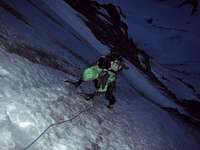
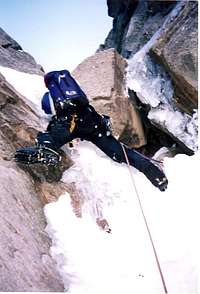
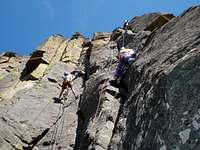

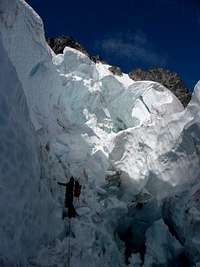
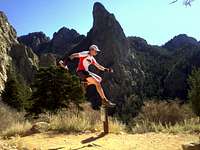


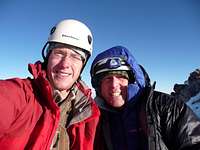

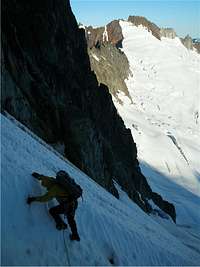


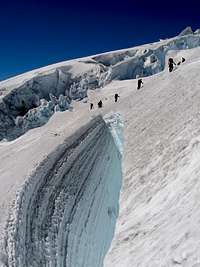

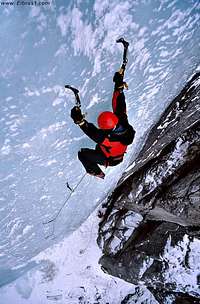

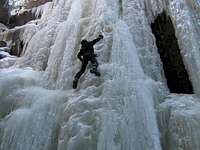
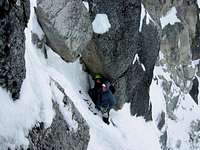


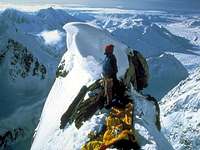








Comments
Post a Comment